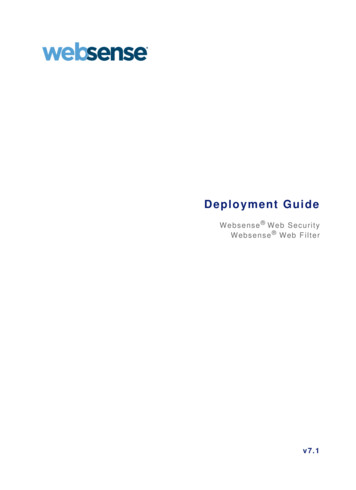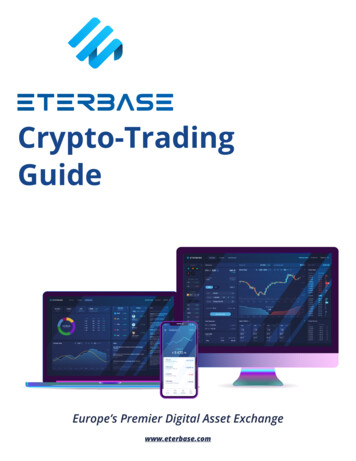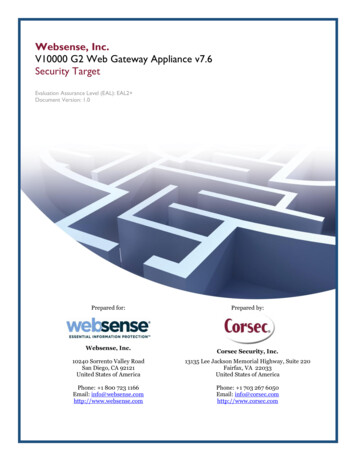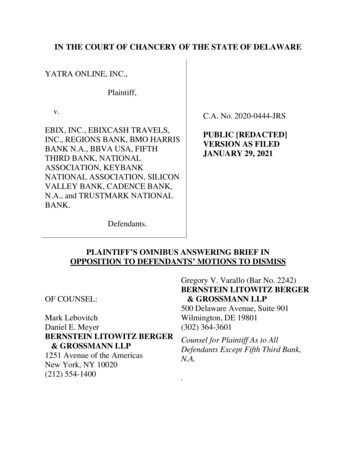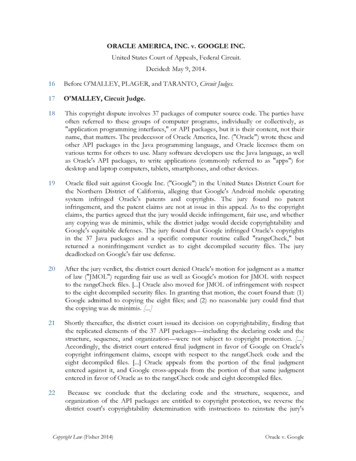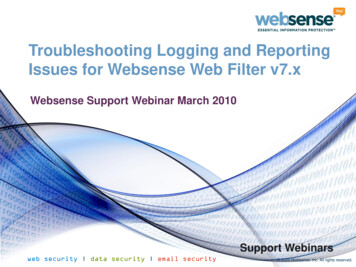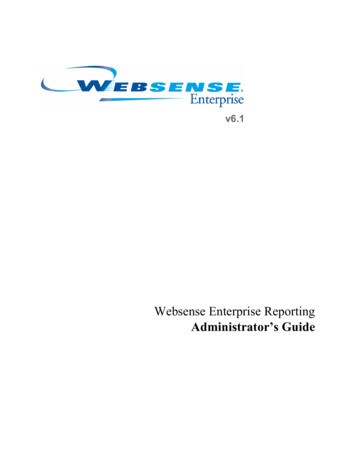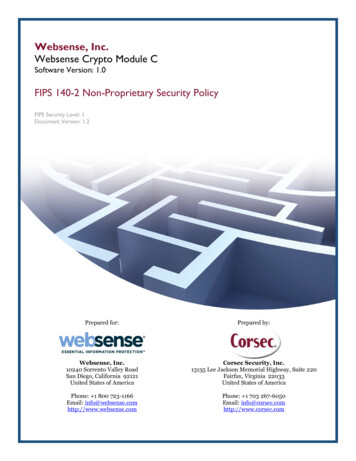
Transcription
Websense, Inc.Websense Crypto Module CSoftware Version: 1.0FIPS 140-2 Non-Proprietary Security PolicyFIPS Security Level: 1Document Version: 1.2Prepared for:Prepared by:Websense, Inc.10240 Sorrento Valley RoadSan Diego, California 92121United States of AmericaCorsec Security, Inc.13135 Lee Jackson Memorial Highway, Suite 220Fairfax, Virginia 22033United States of AmericaPhone: 1 800 723-1166Email: info@websense.comhttp://www.websense.comPhone: 1 703 267-6050Email: info@corsec.comhttp://www.corsec.com
Security Policy, Version 1.2November 8, 2012Table of Contents1INTRODUCTION . 31.1 PURPOSE . 31.2 REFERENCES . 31.3 SUBMISSION PACKAGE ORGANIZATION . 32WEBSENSE CRYPTO MODULE C . 42.1 OVERVIEW . 42.2 MODULE SPECIFICATION. 52.2.1 Physical Cryptographic Boundary . 52.2.2 Logical Cryptographic Boundary . 62.3 MODULE INTERFACES . 72.4 ROLES AND SERVICES . 82.4.1 Crypto Officer Role . 82.4.2 User Role . 92.4.3 Authentication . 102.5 PHYSICAL SECURITY .102.6 OPERATIONAL ENVIRONMENT.102.7 CRYPTOGRAPHIC KEY MANAGEMENT .102.7.1 Key Generation. 132.7.2 Key Entry and Output . 132.7.3 Key/CSP Storage and Zeroization. 132.8 EMI/EMC .132.9 SELF-TESTS .132.9.1 Power-Up Self-Tests . 142.9.2 Conditional Self-Tests . 142.10 MITIGATION OF OTHER ATTACKS .143SECURE OPERATION . 153.1 SECURE MANAGEMENT .153.1.1 Initialization . 153.1.2 Management . 153.1.3 Zeroization . 153.2 USER GUIDANCE .154ACRONYMS . 17Table of FiguresFIGURE 1 – V-SERIES APPLIANCE HARDWARE BLOCK DIAGRAM .6FIGURE 2 – LOGICAL BLOCK DIAGRAM AND CRYPTOGRAPHIC BOUNDARY .7List of TablesTABLE 1 – SECURITY LEVEL PER FIPS 140-2 SECTION .5TABLE 2 – FIPS INTERFACE MAPPINGS .8TABLE 3 – CRYPTO OFFICER SERVICES.8TABLE 4 – USER SERVICES . 9TABLE 5 – FIPS-APPROVED ALGORITHM IMPLEMENTATIONS . 11TABLE 6 – LIST OF CRYPTOGRAPHIC KEYS, CRYPTOGRAPHIC KEY COMPONENTS, AND CSPS. 12TABLE 7 – ACRONYMS . 17Websense Crypto Module C 2012 Websense, Inc.This document may be freely reproduced and distributed whole and intact including this copyright notice.Page 2 of 19
Security Policy, Version 1.21November 8, 2012Introduction1.1 PurposeThis is a non-proprietary Cryptographic Module Security Policy for the Websense Crypto Module C(Software Version: 1.0) from Websense, Inc. This Security Policy describes how the Websense CryptoModule C meets the security requirements of Federal Information Processing Standards (FIPS) Publication140-2, which details the U.S. and Canadian Government requirements for cryptographic modules. Moreinformation about the FIPS 140-2 standard and validation program is available on the National Institute ofStandards and Technology (NIST) and the Communications Security Establishment Canada (CSEC)Cryptographic Module Validation Program (CMVP) website at http://csrc.nist.gov/groups/STM/cmvp.This document also describes how to run the module in a secure FIPS-Approved mode of operation. Thispolicy was prepared as part of the Level 1 FIPS 140-2 validation of the module. The Websense CryptoModule C is also referred to in this document as the cryptographic module or the module.1.2 ReferencesThis document deals only with operations and capabilities of the module in the technical terms of a FIPS140-2 cryptographic module security policy. More information is available on the module from thefollowing sources: The Websense website (http://www.websense.com) contains information on the full line ofproducts from Websense. The CMVP website 0-1/140val-all.htm)contains contact information for individuals to answer technical or sales-related questions for themodule.1.3 Submission Package OrganizationThe Security Policy document is one document in a FIPS 140-2 Submission Package. In addition to thisdocument, the Submission Package contains: Vendor Evidence document Finite State Model document Other supporting documentation as additional referencesThis Security Policy and the other validation submission documentation were produced by Corsec Security,Inc. under contract to Websense. With the exception of this Non-Proprietary Security Policy, the FIPS140-2 Submission Package is proprietary to Websense and is releasable only under appropriate nondisclosure agreements. For access to these documents, please contact Websense.Websense Crypto Module C 2012 Websense, Inc.This document may be freely reproduced and distributed whole and intact including this copyright notice.Page 3 of 19
Security Policy, Version 1.22November 8, 2012Websense Crypto Module C2.1 OverviewWebsense has integrated its portfolio of Web security, email security, and data loss prevention (DLP)solutions into a single, unified, and consolidated offering called TRITON . The TRITON solution is ahighly-flexible and scalable architecture that unifies content analysis, platforms, and security management.Unified content analysis includes real-time threat analysis provided by the Websense AdvancedClassification Engine (ACE). Powered by the Websense ThreatSeeker Network, ACE combines multipleanalytic methods to dynamically classify both incoming and outgoing content. The TRITON solution alsocombines the management and reporting capabilities for Websense Web Security, email security, and DLPtechnologies into a single interface, providing greater visibility, control, and management capabilities. Web Security – Websense Web Security Gateway enables businesses to take full advantage oftoday’s social, interactive Web while lowering costs across the enterprise. Based on the WebsenseTRITON architecture, Web Security Gateway consolidates real-time Web 2.0 security, enterpriseclass DLP, and email security, both in the cloud and on-premises.Websense Web Security Gateway solutions offer:o Zero-day and Web 2.0 malware protectiono Social networking securityo Enterprise-class DLPo Advanced application and protocol controlso Visibility into encrypted SSL traffico Reduced bandwidth consumptiono Lower total cost of ownership Data Loss Prevention – As a part of Websense TRITON solution, data loss preventiontechnologies provide a market-leading DLP capabilities designed to secure sensitive informationand intellectual property. DLP has the ability to detect and discover sensitive data, stored or intransmission, throughout the network and help prevents loss of data through multiple channelssuch as email, Web, USB1 drives, LAN2 storage, and printing.Websense DLP solutions help simplify the task of achieving regulatory compliance by providingcapabilities to manage and enforce regulatory requirements. The solutions also unlock the fullpotential of Web 2.0 applications without the concern for inadvertent or deliberate posting ofinappropriate or sensitive data. Email Security – Websense Email Security Gateway Anywhere provides the next generation ofemail security with fully integrated enterprise-class DLP, superior malware protection with worldclass Web security analytics, and centralized management of email, data, and Web security acrossplatforms in a single, unified console. When integrated with DLP for email traffic, the solutionprovides accurate detection of email traffic without complex tuning, maximum performance andresiliency, and superior malware protection using multiple advanced analytics to defend againstblended attacks and harmful malware.The Websense Crypto Module C provides cryptographic and secure communication services for theWebsense-developed family of solutions described above. These solutions are deployed on threeplatforms: high-performance, pre-configured, security-hardened hardware;1USB – Universal Serial BusLAN – Local Area NetworkWebsense Crypto Module C2 2012 Websense, Inc.This document may be freely reproduced and distributed whole and intact including this copyright notice.Page 4 of 19
Security Policy, Version 1.2 November 8, 2012fully-customizable “ready-to-install” software; andWebsense-hosted services.The Websense Crypto Module C is validated at the FIPS 140-2 Section levels listed in Table 1 below.Table 1 – Security Level Per FIPS 140-2 SectionSectionSection TitleLevel1Cryptographic Module Specification12Cryptographic Module Ports and Interfaces13Roles, Services, and Authentication14Finite State Model15Physical Security6Operational Environment17Cryptographic Key Management18EMI/EMC419Self-tests110Design Assurance111Mitigation of Other Attacks14Cryptographic Module Security PolicyN/A3N/A12.2 Module SpecificationThe Websense Crypto Module C is a software module with a multi-chip standalone embodiment. Theoverall security level of the module is 1. The following sections will define the physical and logicalboundary of the module.2.2.1 Physical Cryptographic BoundaryAs a software cryptographic module, there are no physical security mechanisms implemented; the modulemust rely on the physical characteristics of the host platform. The physical cryptographic boundary of theWebsense Crypto Module C is defined by the hard enclosure around the host platform on which it executes.Figure 2 below shows the physical block diagram of the commercial off-the-shelf (COTS) V-Seriesappliance hardware.3N/A – Not ApplicableEMI/EMC – Electromagnetic Interference / Electromagnetic CompatibilityWebsense Crypto Module C4 2012 Websense, Inc.This document may be freely reproduced and distributed whole and intact including this copyright notice.Page 5 of 19
Security Policy, Version 1.2November 8, 2012Figure 1 – V-Series Appliance Hardware Block Diagram2.2.2 Logical Cryptographic BoundaryFigure 2 below shows a logical block diagram of the module, where “Calling Application” represents anyother software/firmware component loaded on the appliance that employs the module’s services. Themodule’s logical cryptographic boundary (also illustrated in Figure 2) encompasses all functionalityprovided by the module as described in this document. The module takes the form of a single sharedlibrary that can be called by calling applications to provide cryptographic services.Websense Crypto Module C 2012 Websense, Inc.This document may be freely reproduced and distributed whole and intact including this copyright notice.Page 6 of 19
Security Policy, Version 1.2November 8, 2012Figure 2 – Logical Block Diagram and Cryptographic BoundaryThe cryptographic module is a shared library that provides cryptographic and secure communicationservices for other applications developed by Websense. In this document, those applications will bereferred as the calling application. The module is used by the calling application to provideencryption/decryption, hash verification, hashing, cryptographic key generation, random bit generation, andmessage authentication functions.2.3 Module InterfacesThe module’s logical interfaces exist at a low level in the software as an Application ProgrammingInterface (API). The module’s logical and physical interfaces can be categorized into the followinginterfaces defined by FIPS 140-2: Data inputData outputControl inputStatus outputPower inputAs a software module, the module has no physical characteristics. Thus, the module’s manual controls,physical indicators, and physical and electrical characteristics are those of the host platform.Websense Crypto Module C 2012 Websense, Inc.This document may be freely reproduced and distributed whole and intact including this copyright notice.Page 7 of 19
Security Policy, Version 1.2November 8, 2012The FIPS-defined interfaces map to their physical and logical counterparts as described in Table 2 below.Table 2 – FIPS Interface MappingsFIPS 140-2 InterfacePhysical InterfaceModule Interface (API)Data InputNetwork/Serial/USB5 port, DVD6,PCIe7 slotFunction calls that accept, as theirarguments, data to be used orprocessed by the moduleData OutputNetwork/Serial/USB port, DVD,Graphics/Video port, PCIe slotArguments for a function that specifywhere the result of the function isstoredControl InputNetwork/Serial/USB port, LCD8button, PCIe slot, Systemidentification button, Power buttonFunction calls utilized to initiate themodule and the function calls used tocontrol the operation of the module.Status OutputNetwork/Serial/USB port,Graphics/Video, LED9 indicators,LCD, PCIe slotReturn values for function callsPower InputPower plug/adapter, Power SwitchNot Applicable2.4 Roles and ServicesThere are two roles in the module that operators may assume: a Crypto Officer role and User role. TheCrypto Officer is responsible for managing the module and monitoring the module’s status, while the Useraccesses the services implemented by the module. The available functions are utilized to provide orperform the cryptographic services.The various services offered by the module are described in Table 3 and Table 4. The Critical SecurityParameters (CSPs) used by each service are also listed. Please note that the keys and CSPs listed in thetables use the following notation to indicate the type of access required: R – Read: The keys and CSPs are read. W – Write: The keys and CSPs are established, generated, modified, or zeroized. X – Execute: The keys and CSPs are used within an Approved or Allowed security function orauthentication mechanism.2.4.1 Crypto Officer RoleThe Crypto Officer (CO) role is responsible for zeroizing keys and CSPs, executing self-tests, andmonitoring status. Descriptions of the services available to the Crypto Officer role are provided in Table 3.Table 3 – Crypto Officer ServicesServiceInitialize moduleDescriptionPerforms integrity checkand power-up self-testsInputAPI callparametersOutputStatusCSP and Type of AccessIntegrity check HMAC10 key – X5USB – Universal Serial BusDVD – Digital Versatile Disc7PCIe - Peripheral Component Interconnect Express8LCD – Liquid Crystal Display9LED – Light-Emitting Diode10HMAC – (Keyed-) Hash Message Authentication CodeWebsense Crypto Module C6 2012 Websense, Inc.This document may be freely reproduced and distributed whole and intact including this copyright notice.Page 8 of 19
Security Policy, Version 1.2November 8, 2012ServiceDescriptionInputOutputCSP and Type of AccessShow statusReturns the currentmode of the moduleNoneStatusNoneRun self-tests ondemandPerforms power-up selftestsNoneStatusIntegrity check HMAC key – XZeroize keysZeroizes and de-allocates Reboot commandmemory containingor cycling powersensitive dataNoneAES11 key – WTDES12 key – WHMAC key – WRSA13 private/public key – WDSA14 private/public key – WDH15 components – W2.4.2 User RoleThe User role can utilize the module’s cryptographic functionalities. Descriptions of the services availableto the User role are provided in Table 4.Table 4 – User ServicesServiceDescriptionInputOutputCSP and Type of AccessGenerate random Returns the specifiednumber (ANSI16 number of random bits toX9.31)calling applicationAPI callparame
today’s social, interactive Web while lowering costs across the enterprise. Based on the Websense TRITON architecture, Web Security Gateway consolidates real-time Web 2.0 security, enterprise-class DLP, and email security, both in the cloud and on-premises. Websense Web Security Gateway solutions offer: o
